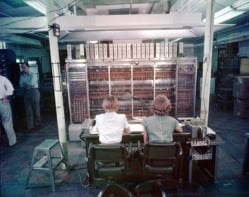Books about single-crystal growth and some of history’s most important science texts, reviewed by Peter Dryburgh and Margaret Harris

One crystal, many industries
It is still not widely appreciated – even by many scientists and engineers – that the growth of single crystals is the foundation upon which most modern technology is built. Without the work of crystal growers, there would be no electronics industry or computers, very little optical industry and some important gaps in conventional production engineering. Many types of single crystal are, for example, required for lasers, while optical components for spectroscopy and detection, scintillators for nuclear physics, diode light-sources, bearings, gemstones and innumerable other applications also make use of these versatile objects. In A Jewel in the Crown, Donald T J Hurle and Keith G Barraclough describe the inner workings of what was, in its heyday, one of the most important crystal growth laboratories in the world: the Royal Radar Establishment (later the Royal Signals and Radar Establishment, RSRE) in Malvern, UK. The workers at this establishment were responsible for an astonishing list of important discoveries and inventions, but perhaps the most impressive was their successful growth of thin layers of cadmium mercury telluride – a component of far-infrared detectors that is arguably the most intractable crystalline material ever employed in device production. Hurle and Barraclough’s book is concentrated and full of details (both technical and historical), and readers who were involved in crystal growth work during what is often regarded as the “golden era” of 1970–1990 will find it a delight. But the book also has implications that stretch well beyond one field or institution. After a series of amalgamations in the 1990s, the remains of RSRE were eventually floated on the London Stock Exchange as part of a commercial company, QinetiQ. Yet during its years as a state-run organization, the RSRE was both monumentally successful and the driving force behind the creation of successful specialist companies. Politicians who believe they can organize scientific research should consider its history very seriously.
- 2014 Aspect Design £9.99pb 126pp
How science developed
“To interpret science, we have to know something about its past. We have to continually ask not just ‘What have we discovered?’ but also ‘Why did we look for it?’ ” In The Story of Science, Susan Wise Bauer sets out to answer these questions by analysing some three dozen notable science texts from history, beginning with the Aphorisms of Hippocrates (“the first surviving book of science”) through to James Gleick’s 1987 popular-science book Chaos. In the earliest texts, the science is generally wrong (and sometimes, to quote a New Yorker cartoon, “wrongedy-wrong-wrong”), but despite this, Wise Bauer argues convincingly that scientists as well as historians should be interested in what the authors had to say. Robert Boyle’s treatise The Sceptical Chymist, for example, advocates an erroneous 17th-century theory of matter, yet many of the methods Boyle describes are sound. As Wise Bauer puts it, “its place in history is assured not by its conclusions, but by its procedures; not by the truth it discovers at the end, but by the road it takes to get there”. Sometimes, Wise Bauer demonstrates the continued relevance of old texts by showing how old ways of thinking have endured. The medieval division of the world into animal, vegetable and mineral, for example, influenced the Linnaean system of taxonomy that biologists still use today, and as Wise Bauer points out, it also lives on in the parlour game “20 Questions”. The Story of Science can be read on its own, but for those who wish to use it as a companion book to the original historical texts, the author includes some helpful and practical advice about translations.
- 2015 W W Norton £16.99/$26.95hb 336pp



